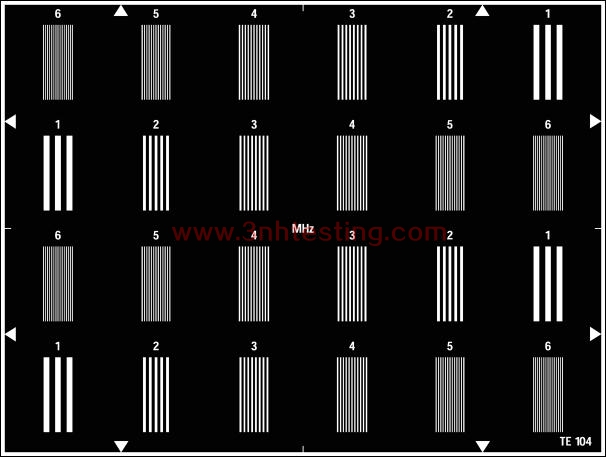MULTI BURST TEST CHART
- Introduction
- Product Software
MULTI BURST TEST CHART (1 - 6 MHz)
REFLECTANCE

The test chart is designed for resolution measurements, mainly for visual test.
The chart consists of 4 rows with each 6 fields of multiburst of frequencies from 1 to 6 MHz.
The order of fields is switched in every second row. Only a limited depth of modulation
measurement is possible because there is no 0.5 MHz reference on the chart. You can
use the 1 MHz as a reference but be aware, that the results are not comparable with
usual measurements with e.g. T03, T07, TE99 and TE107. But there are more fields with
different frequencies available as e.g. in T03 and TE176 and the different frequencies
are better distributed over the picture area compared to e.g. the T07, TE99 and TE107.
Measuring equipement: video oscilloscope, preferably with memory function
Measuring conditions: The camara setting must be as follows
Shading correction: ON
Aperture correction: OFF
Gamma correction: OFF
Contour correction: OFF
Color correction: OFF
Iris: F/5.6 for 2/3” CCD, F/4 for 1/2” CCD
The test chart is evenly illuminated so that for the frequency burst at 1 MHz the amplitude
of the video signal at the output of the correctly positioned and focussed camera is 0% (0V)
for the black bars and 100% (700mV / 75 Ohms) for the white bars.
Care must be taken to avoid clipping of the signal to be measured at the black and white level.
Measurement procedures
Measurements can be made on the various camera output signals, but preferably on the
Y luminance signal (or coded Y with perfect B and W balance). The measurement is made
at the center of the image and at the corners so that account is taken of the lateral chromatic
aberation of the lens. In addition to determining camera response to the particular value of 5
MHz, measurement according to the spatial frequency of the test chart. Frequency bursts of
1 MHz and 2 to 6 MHz are recommended for this measurement. The measurements give the
contrast loss of the camera response at the value of 2 to 6 MHz. The obtained response is
a contrast transfer function (CTF).
Mathematical relations can be used to calculate the MTF according to the CTF values:
MTF(N)= π/4[CTF(N) + 1/3 CTF(3N) - 1/5 CTF(5N) + 1/7 CTF(7N) - 1/9 CTF(9N) + 1/11 CTF(11N) ...]
where N is spatial frequency of the test chart analysed; N in TVL/H
News
- 2014-06-12 Human Eyes to Distinguish Colors
- 2017-07-08 How to use SFR resolution test char ...
- 2014-06-12 Pantone TPX 2012 (175 New Colors)
- 2014-06-12 Colorimeters Versus Spectrophotomet ...
- 2014-06-12 Color Fastness
- 2024-03-08 New company name Guangdong ThreeNH ...
- 2024-04-29 New Guangdong ThreeNH bank account
- 2014-06-26 3nh TUV Certificate
.png)



.jpg)
.jpg)
.jpg)
.jpg)

